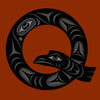Sisiutl and Thunderbird Panel by Bill Henderson, Kwakwaka'wakw
Regular price
$0.00
Sale
by Bill Henderson, Kwakwaka'wakw First Nations
red cedar, abalone inlay, pigment
22" high x 58" wide x 6" deep
Tseigami is a man who comes from the cedar tree and Thunderbird, lord of the winter dance season, a massive supernatural bird whose wing beats cause the thunder, and the flash of whose eyes causes lightning. Tseiqami hunts whales for its dinner out at sea, and sometimes helped heroic ancestors build houses by placing giant cedar beams for them.
Thunderbird's adversary is Qaniqilak, spirit of the summer season, is often identified as the sea god, Komokwa, Chief of the Sea. Many Kwakwaka'wakw families have been blessed by riches and supernatural treasures bestowed by this god of the tides and maker of coppers.
Sisiutl is a giant three-headed sea serpent whose glance can turn an adversary into stone. Cross beams of clan houses sometimes are carved with his appearance. Blessed ancestors have sometimes received sisiutl's help when he transforms himself into an invincible war canoe, and sometimes into a magic belt with which to gird oneself against all dangers.
Thunderbird and Sisiutl are the Henderson Family crest symbols. If you travel to Campbell River, British Columbia, you will see these symbols painted on the front of the Kwakwaka'wakw Long House. Bill Henderson and his brother Mark were the main carvers and painters of this important structure.
Master Carver Bill Henderson was born into the Weiwaikum band of the Kwakwaka’wakw Nation on March 21, 1950. Bill is one of nine sons of the late Chief Sam Henderson and May Quocksister Henderson. As a child, Bill learned the ways of an artist by watching his father, a self-taught carver. Sam and May Henderson are well-remembered as protectors of ancient customs, and they instilled in all their children respect for their cultural heritage.
At age seven, Bill carved a little whale plaque for his Grade 1 teacher; it is still proudly displayed at Campbellton School. Young Bill would draw and paint stylized figures from Kwakwaka’wakw mythology on pieces of leftover plywood in his father’s shed – a shed he has carved in now for nearly half a century.
In his late teens, Bill took up carving more seriously and at 19 he began to sell his work. Since then, he has honed his skills while preserving the family’s traditional style in carvings, dance masks, paddles, bowls and plaques. While he was always drawn to painting and the culture of carving, Bill never dreamed that his work would become sought-after in a global marketplace.
Over the years, Bill has carved hundreds of masks for private collectors and ceremonial dances. The masks represent figures from Indian mythology and bring from images long ago to life with music, movement and song. Kwakwaka’wakw ceremonial regalia is among the most elaborate of all the Northwest Coast tribes.
A professional Native dancer, Bill performs at numerous potlatches and ceremonies. The symbolism of the mystic character he portrays in dance can be seen in his art, be it the Crooked-Beak-of-Heaven, the Grizzly Bear, or the Sea-Monster. The dance ‘Hunter of the Woods’ was gifted to Bill by his father during a potlatch; it belongs to him alone.
The Museum at Campbell River has Bill’s ceremonial masks on permanent display. One large, powerful mask describes the legend of Yagis, or "Bad Thing from the Sea", a powerful sea-monster that causes storms and threatens fishers. In the museum’s Sewidi collection, Bill’s "Octopus" mask features eight tentacles that can each be manipulated by the dancer.
An achievement he is proud of is the creation of ceremonial regalia for other chiefs' lineages. On nearby Quadra Island, Bill’s art is part of the ceremonial regalia exhibit at the Kwagiulth Museum and Cultural Centre, and a Henderson totem graces the museum entrance. At Ishikari, Japan, one of Bill’s totems stands in front of city hall - a ‘sister city’ gift from Campbell River in 1993.
Three majestic Henderson totems stand at the entrance to Wei Wai Kum House of Treasures at Discovery Harbour Shopping Centre. One 30-foot pole is topped by a powerful mythical bird, with a whale and a bear holding a salmon beneath. A beaming sun figure tops the larger 40-foot pole, with a man beneath holding copper – a sign of wealth. The third pole is topped by an eagle with the three-headed serpent beneath. The heads on a totem are large to give the creature a fearsome look, while the body is small. Traditional Kwakwaka’wakw colors of deep green, red and black predominate.
The creative traditions of the Henderson family are now being nurtured by a third generation; Bill mentors his nephews, Junior, 24, and Greg, 31. Using methods handed down through time, they still fashion all their own tools; blades from old net fishing knives are bent, tempered, sharpened and then attached to cedar handles with fishing twine.
At the Memphis Zoo in Tennessee last summer, Bill, Greg, Junior and Mark Henderson were all present at pole-raising ceremonies for twin totems carved earlier in the year.
When the Henderson children were young, an aunt would tell them bedtime stories, dream-weaving tales from a mystical past. Katie Adams is now 100 years old, and the stories live on in the carvings. Bill dreams of carving a giant, opened clam shell; from inside the shell will creep the cockle-hunters that come in the night. When that vision is created, another legend of the Kwakwaka’wakw Nation will be preserved.








